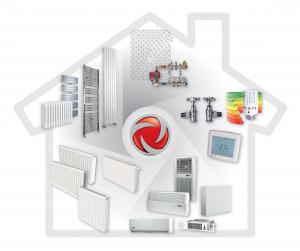Gone are the days when a central heating system automatically meant one boiler and a set number of radiators. Nowadays the possibilities are far wider and there is a perfect solution for each project, says Andrew Lowery, Marketing Manager for Myson UK.
Times and lifestyles have moved on in the last decade, and so have the options when choosing heat emitters. The basics of specifications have not changed; you still need to take into account room dimensions, insulation levels, numbers of doors and windows and whether a wall is internal or external; and you still need to perform a heat loss calculation to determine your output requirement room by room, but you can now do this online using the Myson Heat Loss Calculator. How you provide that heat is now more flexible.
If the property already has central heating and the homeowner is looking for a like for like replacement, the advances in radiators since their last system can mean big savings on running costs. Most people are well aware that a new condensing boiler means reduced bills, but this is really only true if you are using newer radiators, which have lower water content and a greater heat emitting surface than their older counterparts. New radiators are designed to emit more heat from the same footprint, so they allow you to turn down the system temperature and use the new boiler in true condensing mode, which is what truly delivers the energy savings.

Newer radiators are more attractive than older ones, so replacing them is a great idea aesthetically too. Flat fronted panel radiators such as the Plan Compact range lend a great deal more style for not a lot more investment. The flat fronted design is also easier to clean and are very popular with house-proud homeowners. There’s choice with these too; you can opt for a completely plain minimalist front panel, or choose one with a fine detail, such as the subtle horizontal lines of the Plan Compact Plus.
Panel radiators are not the only option, however, and neither is just one type of heat emitter. Increasingly, we are combining more than one type of heat emitter in a single property to provide a total solution that takes into account lifestyles and patterns of usage to achieve the best results and the most economical running costs.
We are already familiar with the idea of having a different type of radiator in the form of a towel warmer in bathrooms, en-suites and cloakrooms. The open design offers towel storage and drying as well as allowing heat to escape into the room to provide ambient warmth. Its practicality now makes it an obvious choice in these rooms, but the possibilities can go much further than that.
One trend which is definitely growing, is the use of underfloor heating on the ground floor and radiators on the upper floors. This is really popular in properties with larger open plan living, dining and kitchen spaces on the ground floor and more defined areas in the form of bedrooms on the upper floors. The use of radiators allows individuals to adjust the level of warmth in their own space or to turn the radiator down if they prefer a colder room to sleep in, or to boost the heat if studying or working from home. On the ground floor, where the most time is spent together, the underfloor heating provides steady, economical warmth without taking up any wall space; allowing furniture to be placed in any formation and to be changed at will from season to season. You also never need to consider how the heat emitter will look when decorating as it is completely hidden.
In kitchens, where space is often at a premium, another option to consider is the Kickspace fan convector. This is mounted into the plinth beneath a kitchen base unit, to provide ample warmth without taking up any wall space at all. This is also a rapid way of heating up a small space in cold spells; and you can install a dual fuel version which can operate even when the rest of the heating is switched off. Tall, vertical radiator styles are also increasingly popular as space saving solutions, as they add elegance and style while providing large heat outputs. These add a sculptural feature, making a clever decorative, as well as functional, use of limited wall space.
When planning a new heating system, it is entirely feasible to use any combination of heat emitters, including underfloor heating, radiators, towel warmers and fan convectors. Our technical team responds to a great number of requests for help with system design and around 30% of these now involve combinations of heat emitters.
Controlling the system well is the key to keeping domestic fuel bills low. This is partly down to installing good controls. The Myson Touch 2 Wi-Fi gives you great control over the system, even when you are not home. As well as providing routine switch on and off timings for weekdays and weekends, if the weather turns unexpectedly colder, it also lets you turn the heating on from work, or when you’re on your way home from holiday, to make sure you come home to a warm and comfortable home.
System efficiency also depends on all the different heat emitter types working well together, so it is wise to source them all from the same manufacturer. This not only gives you the reassurance that they have been designed, developed and tested to ensure that they all work effectively together, it also gives you access to system guarantees, and the peace of mind of knowing that they are good quality products manufactured to the highest standards.
The best total solution for each individual project is just that – individual. Carefully selecting the optimum combination of products each time is the best way to guarantee long term reliability and efficiency; and a lot of word of mouth recommendations from satisfied customers.


Add new comment